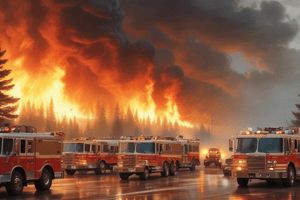Podcast
Questions and Answers
What is a key characteristic of a Marginal situation?
What is a key characteristic of a Marginal situation?
- It features defensive conditions with a known rescue. (correct)
- It involves conditions that are strictly offensive.
- It allows Command to ignore rapid condition assessments.
- It has an indefinite window for rescue attempts.
What is the primary responsibility of the Incident Commander in a Marginal situation?
What is the primary responsibility of the Incident Commander in a Marginal situation?
- To wait for firefighters to assess the building conditions first.
- To pass the decision-making authority to Sector Officers.
- To control overall incident scene safety by determining strategy. (correct)
- To focus solely on offensive strategies until a crisis occurs.
Which action should be prioritized by Command during a Marginal situation?
Which action should be prioritized by Command during a Marginal situation?
- Delaying the assignment of a Roof Sector for strategic planning.
- Ignoring roof conditions while focusing on interior attacks.
- Constantly evaluating conditions through frequent reports. (correct)
- Only relying on prior strategies without reassessment.
What should Command consider regarding interior crews during a Marginal situation?
What should Command consider regarding interior crews during a Marginal situation?
What is the risk of delaying a strategy change from offensive to defensive in a Marginal situation?
What is the risk of delaying a strategy change from offensive to defensive in a Marginal situation?
Flashcards are hidden until you start studying
Study Notes
Marginal Situations in Incident Command
- Defined as defensive conditions where a rescue is known to be possible.
- Can have a very short time frame to decide between continuing a rescue or shifting to a defensive fire attack.
Command Strategies
- Command must clearly communicate the conditions during Marginal scenarios.
- Changes in strategy may happen quickly or take longer, requiring constant assessment from the Incident Commander.
- It's crucial for Command to adapt the strategy according to the real-time conditions of the fire scene.
Role of the Incident Commander
- Responsible for overall safety and determining the appropriate strategy and tactics.
- Delays in changing from offensive to defensive strategies can lead to structural damage and danger for firefighters.
- Building conditions should not dictate strategy; it is vital for Command to lead the decision-making process.
Importance of Reports and Assessments
- Continuous condition evaluation is necessary, demanding detailed updates from Sector Officers.
- Assigning a Roof Sector early is critical for evaluating roof safety and structural conditions.
Safety Protocols
- Command should consider not sending crews inside a structure unless Roof Sector reports that it is safe.
- A proactive approach prioritizing early transition to defensive strategy can prevent potential traumatic incidents for firefighters.
Studying That Suits You
Use AI to generate personalized quizzes and flashcards to suit your learning preferences.



